7 Strategic Trends in Manufacturing Digitalization and Automation for 2024
2023-12-29
In today's industrial environment, it's important to understand that trends in production and automation are the driving forces behind changes that respond to various global challenges and technological advancements. The development and implementation of advanced technologies such as intelligent autonomous agents, autonomous mobile robots (AMRs), and AI-controlled quality control systems are examples of innovative solutions that respond to the need for higher efficiency, more flexible adaptation to variable market demands, and increased sustainability.
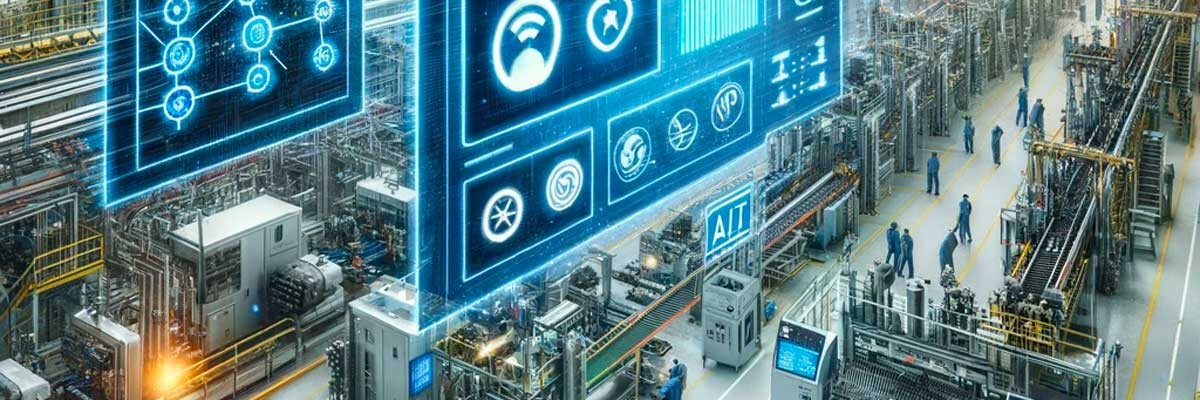
These trends reflect changes not only in the technological aspects of production but also in the socio-cultural factors of the work environment, such as increased remote work and the need for digital skills among employees. Manufacturing companies must adapt not only to rapidly changing technological trends but also to dynamic shifts in the work environment and the global context. This shift requires a holistic approach to digital transformation, where managers must integrate new technologies with changes in work processes and strategies, similar to trends in logistics for 2024.
Overall, these trends represent a fundamental change in how manufacturing companies operate and demand from production managers not only technical knowledge but also more strategic and adaptive thinking.
TREND NO. 1: INTELLIGENT AUTONOMOUS AGENTS
Integration of intelligent software bots into manufacturing processes
Intelligent autonomous agents, known as dynamic digital twins, are being integrated into manufacturing and operational processes. Digital twins are designed to control and streamline manufacturing and associated processes through advanced artificial intelligence (AI) algorithms. Their purpose is to continuously analyze production data, make numerous real-time decisions, and autonomously perform assigned tasks in production to optimize workflows.
How it works?
- Continuous analysis of production data: Digital twins constantly collect and analyze data from production processes, including performance, quality, and utilization of operational resources.
- Autonomous decision-making and task execution: The twins use AI for decision-making, identifying optimal workflows, and automating tasks such as adjusting production parameters based on current supply and demand, mass customization of products in serial production, or specific requirements for supplying production lines.
- Real-time adaptation to changing circumstances: Digital twins dynamically respond to ongoing changes in operational environments and supply chains, adjusting manufacturing processes according to current needs, priorities, and circumstances.
What are the practical benefits?
- Increased operational efficiency: Deploying autonomous software bots into production enhances productivity, reduces errors, and improves the overall efficiency of manufacturing processes.
- Reduction of production errors: Automating decision-making processes reduces the risk of errors caused by human factors not only in production but also in associated processes.
- Enhancement of manufacturing agility: Digital twins enable rapid adaptation to dynamic changes, expanding operational flexibility and the ability to swiftly respond to market and customer needs and preferences.
- Optimization of operational costs: More efficient utilization of company resources and optimization of the budget associated with production and maintenance.
Autonomous information agents, acting as digital twins, handle tasks independently and unsupervised, responding to environmental changes and autonomously making decisions about production procedures and operations to achieve the best results. Digital twins are a fundamental part of modern Smart Industry systems equipped with adaptability, scalability, agility, and various cognitive competencies.
Thanks to decentralized multi-agent technology, these systems can effectively manage complex manufacturing and logistics processes, adapt to rapidly changing conditions, and enable flexible operation management. Systems with digital twins are becoming a necessity for dynamic and unpredictable manufacturing and logistic environments.
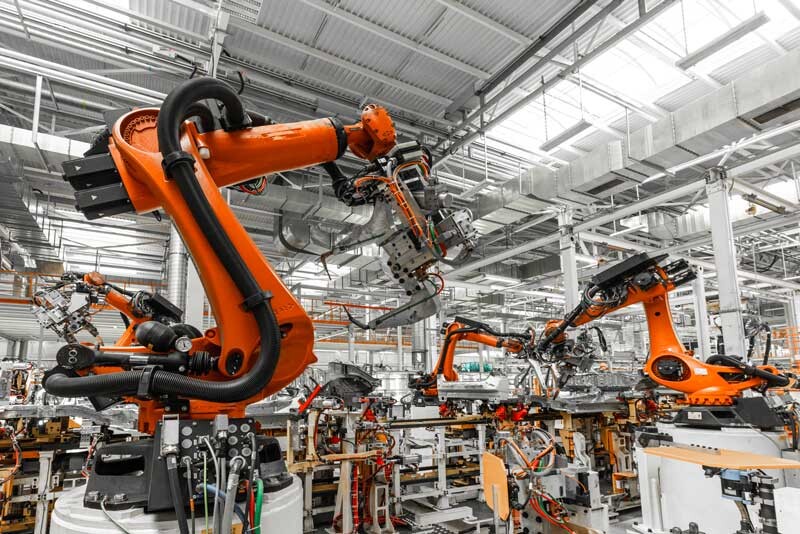
TREND NO. 2: INTEGRATION OF AUTONOMOUS MOBILE ROBOTS (AMR) INTO PRODUCTION
Expanding the fleet of autonomous mobile robots in manufacturing operations
Intralogistics holds a significant position in manufacturing operations. As part of improving the productivity of manufacturing processes and their flexibility, there will be an expansion in the utilization of autonomous mobile robots (AMRs) on production lines and in production logistics. These robots are designed for autonomous material transportation and handling within operations and plants.
They can thereby automate and optimize material flow in production. AMRs can dynamically maneuver between the warehouse and the production line, adapting to changes in production lines and processes. Simultaneously, they operate safely alongside human workers, increasing productivity and reducing the need for manual labor.
How it works?
- Autonomous transportation: AMRs utilize advanced navigation technology for autonomous material transport and component manipulation in operations without the need for manual intervention in processes.
- Flexible adaptation to operations: Transport robots are equipped with sensors and algorithms that allow them to identify and react to obstacles, changing layouts in operations, and other dynamic elements of the environment or processes.
- Collaboration with workers: AMRs are designed to safely collaborate with human workers, enhancing workplace safety, ergonomics, and process efficiency.
What are the practical benefits?
- Optimization of material flow: Speeding up and refining material transfers through robots means better work organization, more precise synchronization of production procedures, and shortened production cycles.
- Reduction of manual labor: Automating material transport reduces the need for manual intervention in material transfers and handling. This allows employees to focus on more complex tasks.
- Increasing productivity: Rapid, precise, and error-free material transport by robots contributes to overall productivity improvement and more efficient utilization of company resources.
- Flexibility in production procedures: AMRs provide a high level of flexibility to operations and manufacturing processes. Hence, they can be easily relocated to other zones or workplaces or dynamically redistributed and deployed into processes according to current production needs.
Integrating autonomous mobile robots (AMRs) into manufacturing processes represents a significant advancement in production automation and optimization. Apart from increasing flexibility in manufacturing lines, they also enable quick adaptation to changing market demands and improve employees' working conditions, as AMRs can perform routine and repetitive tasks for them.
AMRs efficiently utilize resources, optimize material flow, and reduce waste, resulting in cost savings. These robots incorporate advanced technologies such as machine learning algorithms and sophisticated sensors, enhancing productivity and ensuring safety when interacting with human workers. The integration of AMRs represents a key step not only in increasing efficiency and productivity but also in readiness for upcoming technological innovations within the concepts of Industry 4.0 or Smart Factory.
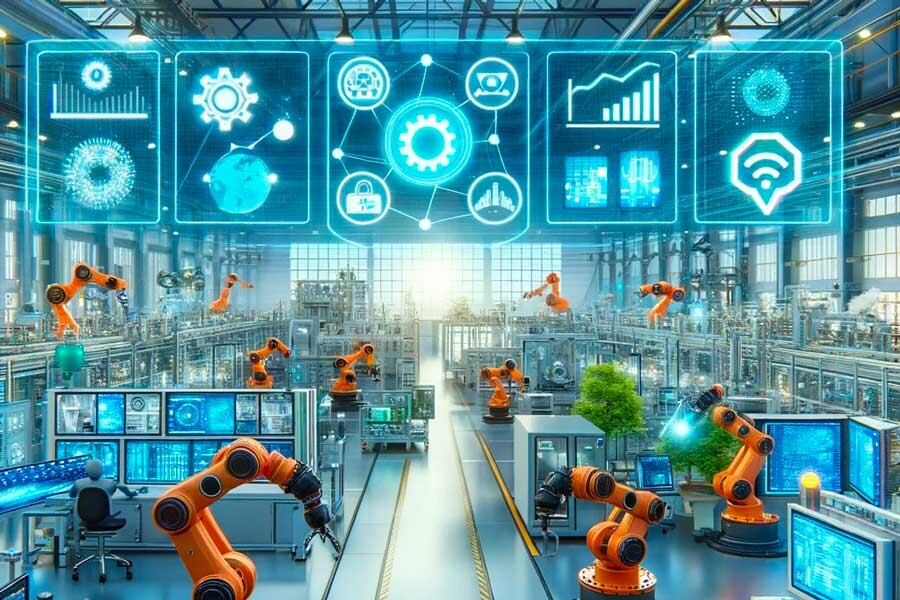
TREND NO. 3: CYBER-PHYSICAL PRODUCTION SYSTEMS
Implementation of cyber-physical systems (CPS) for advanced automation from data analysis to autonomous process control
Cyber-physical systems (CPS), such as controlling MES systems, allow the interconnection of physical operating objects (enterprise resources), and consequently, manufacturing operations, with digital technologies.
CPS provides production managers the ability to increase automation, improve precision and consistency in manufacturing processes, and simultaneously reduce production time and costs. Additionally, these systems enable rapid adaptation to market changes and customer demands, providing operations with a strategic advantage in a dynamic industrial environment.
How it works?
- Linking physical and digital manufacturing: CPS utilizes sensors, detectors, and IoT technologies to collect and analyze data from the physical production process, providing an accurate overview of production status and performance in real-time.
- Intelligent control and automation: These systems use data to automate decision-making and processes, allowing production lines to adapt to changes without manual interventions and adjustments.
- Autonomous manufacturing environment: CPS enables production lines and workplaces to dynamically adjust to changing conditions and promptly respond to unplanned events or unexpected circumstances, leading to significant improvements in process efficiency and flexibility.
What are the practical benefits?
- Increased efficiency and flexibility in production: Implementing CPS in operations allows for a quicker and more effective response to changes in demand, production conditions, or macroeconomic circumstances.
- Elimination of errors and guarantee of 100% quality: Process automation and intelligent control eliminate the risk of errors, ensuring consistent product quality and zero percent scrap.
- Optimization of production processes: CPS enables companies to utilize all their resources more efficiently and optimize costs through more effective management and operation.
- Improvement in workplace safety and ergonomics: Intelligent monitoring and control of operations significantly improve the safety of the work environment and ergonomics for employees.
The deployment of cyber-physical systems represents a critical bridge between IT and manufacturing for production companies, significantly pushing the boundaries of efficiency and innovation in the industry. These systems connect advanced information technologies with physical manufacturing operations, allowing precise control and real-time monitoring of production processes.
Such synergistic linkage improves automation, enhances production quality, and supports flexibility in response to changing market demands. The result is the creation of intelligent, self-directing, and self-adjusting manufacturing environments capable of rapid adaptation and transformation.
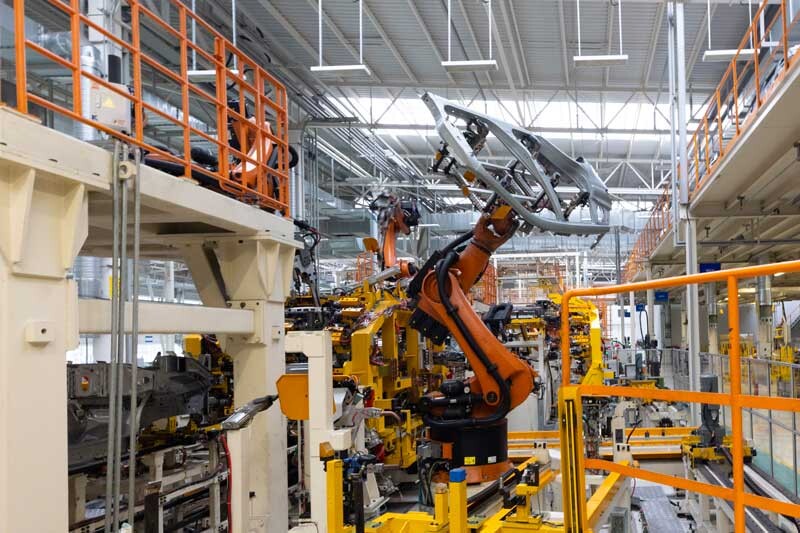
TREND NO.4: AI-POWERED QUALITY CONTROL SOLUTIONS
Deployment of AI-driven quality control solutions that automatically identify errors and deviations in real-time
The use of AI in quality control solutions forms another part of process automation in a manufacturing enterprise. Advanced image recognition algorithms and machine learning constantly evaluate and identify potential defects and inconsistencies on production lines, workstations, semi-finished goods, components, and products. This ensures compliance with the highest quality standards and reduces the rate of failures in processes.
How it works?
- Advanced image recognition and data analysis: Solutions utilize AI and machine learning to analyze image data from production lines and workstations, detecting qualitative deviations or defects such as cracks, surface inconsistencies, geometric errors, and other anomalies.
- Automatic detection and classification of errors: AI quality control solutions can automatically identify and classify types of errors, enabling quick and accurate responses to quality issues.
- Continuous monitoring and immediate intervention: AI-driven solutions continuously monitor production processes, lines, and workstations. In case of deviations, they provide timely warnings, reducing the number of product defects.
What are the practical benefits?
- Enhancement of production quality and flawlessness: Using AI for quality control increases precision and consistency in manufacturing processes.
- Reduction in errors and costs: Automation of quality control minimizes the risk of human errors and reduces costs associated with failures, waste, repairs, and spare parts.
- Improvement in production procedures: AI-driven quality control solutions provide detailed insights into manufacturing processes, enabling the identification and resolution of root causes of errors, and eliminating their repetition.
- Quick adaptation to changes in products: The flexibility of AI quality control solutions allows swift adaptation to changes in product design or specifications without the need for extensive manual reconfiguration of manufacturing equipment.
Introducing AI-driven quality control solutions brings new opportunities for technological precision and process innovation to manufacturing companies. This evolution, apart from enriching existing production procedures, also opens doors to new tools in management and data analysis. The streamlining of processes through AI, coupled with this technology's ability to adapt to changing manufacturing requirements, enables businesses to achieve unprecedented quality assurance results.
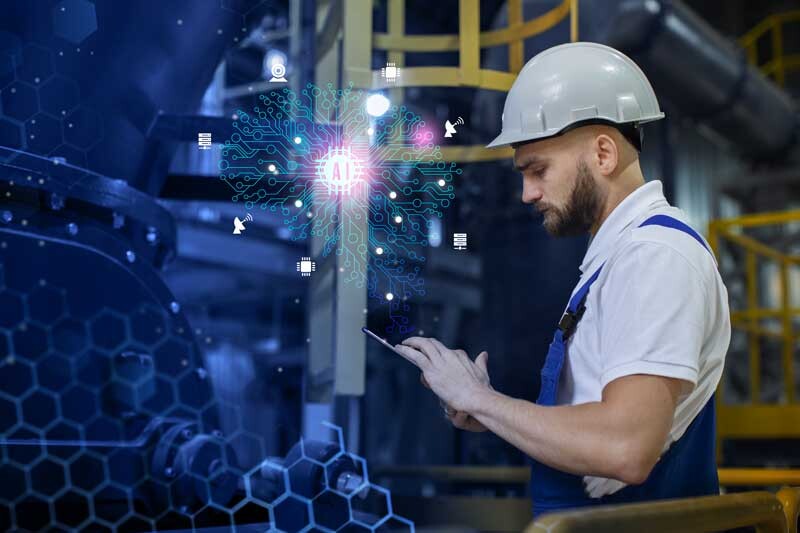
TREND NO.5: DYNAMIC WORKFORCE
Digital transformation of human resources in manufacturing processes
Digital transformation, especially considering ongoing changes stemming from the expansion of AI, also touches on the social aspects of work. This primarily involves integrating remote collaborative models and advanced artificial intelligence (AI) applications into operations.
This synergy provides manufacturing managers with new possibilities for more efficient coordination and process management, even remotely, utilizing data analysis and automation through AI solutions to optimize manufacturing operations. Such integration enables businesses to better adapt to rapidly changing market conditions and thus maximize the efficiency of their production strategies.
How it works?
- Hybrid workspaces: Utilizing a combination of human and machine cognitive abilities, with emphasis on AI and machine learning, allows the creation of workplaces where human intuition meets machine accuracy.
- Expansion of digital skills: Employees must adapt and expand their digital skills to cope with new challenges and opportunities arising from the digitization of work processes.
- Virtual and augmented work environments: Implementation of virtual and augmented realities in workplaces that enable employees to interact and collaborate in a digital environment.
What are the practical benefits?
- More flexible operational strategies: Embracing more flexible operations and digitization to enhance resilience and flexibility in manufacturing processes.
- New job positions: Emergence of new, digitally oriented job positions.
- Improved collaboration and communication: Digitization allows better collaboration and communication among different departments and locations, even for teams from various countries.
The trend of a dynamic work environment and human resource transformation represents not only a technological shift but also a significant change in the culture and organization of the manufacturing industry. This change is primarily driven by the need for continuous adaptation to rapidly changing market conditions, technological innovations, and evolving competition. As a result, companies are required to transition to more flexible and digitized work procedures, which are fundamental prerequisites for maintaining and increasing competitive advantage.
TREND NO.6: ADVANCED ENERGY MANAGEMENT SYSTEMS
Transformation into energy-efficient operations through the utilization of intelligent energy management systems
The current trend in manufacturing management focuses on the implementation of sophisticated energy consumption management systems. These systems, designed with an emphasis on technological precision and efficiency, aim not only to optimize energy consumption within the use of manufacturing and assembly equipment but also to reduce energy waste.
A key aspect also involves supporting the use of renewable energy sources, enabling companies to reduce their carbon footprint while simultaneously streamlining energy costs. This approach primarily includes advanced monitoring and analysis of energy usage, allowing companies to more efficiently manage energy resources and promote sustainable manufacturing strategies.
How it works?
- Monitoring and analysis of energy consumption: Systems continuously monitor and analyze energy consumption within manufacturing operations, identifying areas of inefficient energy usage in specific manufacturing or transportation equipment.
- Automated optimization: Intelligent algorithms automatically adjust the settings of manufacturing equipment and processes to reduce energy consumption without negatively impacting operational productivity.
- Integration with renewable energy sources: Systems can be integrated with renewable sources, such as solar panels, for more efficient utilization of sustainable energy.
What are the practical benefits?
- Reduction in energy costs: More efficient energy management significantly reduces operational energy costs.
- Decrease in environmental impact: Optimizing energy consumption and using renewable sources contribute to reducing greenhouse gas emissions and enhancing the sustainability of manufacturing operations.
- Enhanced corporate social responsibility: Implementing sustainable practices and focusing on renewable energy sources improves the company's public image and corporate social responsibility.
- Increased efficiency and productivity: Energy management systems enhance overall manufacturing process efficiency, leading to higher productivity.
Advanced energy management systems are an integral part of achieving higher energy efficiency and sustainability in modern manufacturing enterprises. These systems utilize the latest technologies in consumption analysis and optimization, enabling companies not only to significantly reduce operational costs and emissions but also to become leaders in innovation and environmental responsibility. With their assistance, manufacturing companies can effectively integrate sustainable practices into their operations, thereby increasing their market value and showcasing their commitment to ecological sustainability.
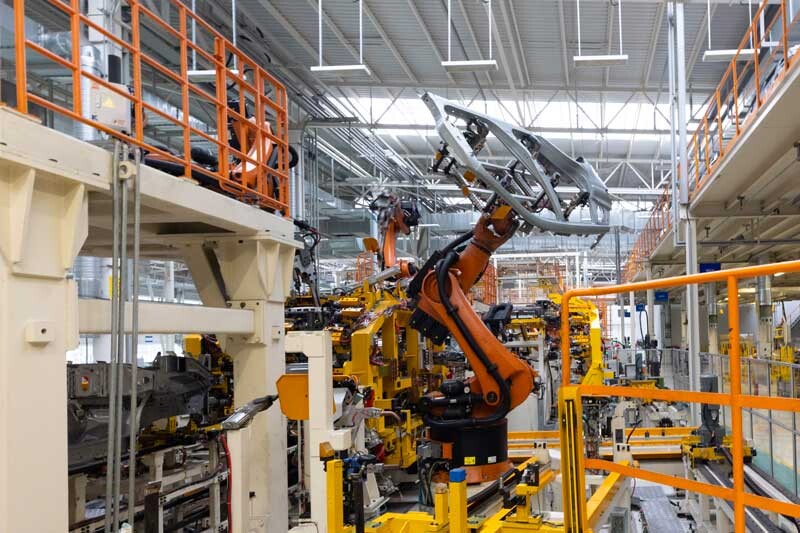
TREND NO.7: TECHNOLOGIES FOR SUPPLY CHAIN RESILIENCE ENHANCEMENT
Development and implementation of technologies to ensure accuracy, timeliness, and flawless supply chain flows
Geo-political events and de-globalization trends have influenced changes in supply chains. Hence, businesses are focusing on developing and implementing technologies aimed at enhancing their resilience and flexibility. This includes using predictive analytics to efficiently manage risks, employing artificial intelligence (AI) for sophisticated supplier evaluation and selection to ensure high transparency and security across the entire supply chain.
How it works?
- Predictive analytics for risk management: Utilizing data analytics tools to identify potential risks and weaknesses in the supply chain, enabling preemptive measures to prevent disruptions and delays.
- AI for supplier assessment: Implementing AI for automated evaluation of supplier performance and reliability, simplifying supplier selection and auditing.
- Transparency and security: Incorporating digital technologies to ensure immutable records and transparency throughout the supply chain, improving product traceability, and safeguarding against fraud.
What are the practical benefits?
- Increased resilience and flexibility: These technologies enable faster and more effective responses to challenges and changes within the supply chain.
- Improved risk management: Predictive analytics and AI help identify and manage potential risks before they become problematic.
- Enhanced transparency and trust: Heightened trust and transparency in supply chain processes, especially crucial in the global trade environment.
- Optimization of supplier selection: AI provides companies with tools for more effective assessment and selection of suppliers based on performance, reliability, and other criteria.
The development and implementation of advanced technologies focused on strengthening the resilience of supply chains are essential to ensure their reliability in dynamic, and often unpredictable, business environments. These innovations provide companies with tools for enhanced risk management and increased process transparency, allowing businesses to collaborate more effectively with suppliers.







